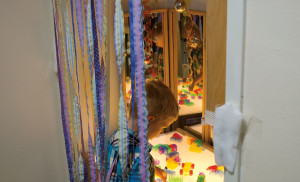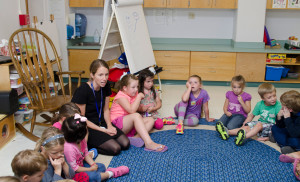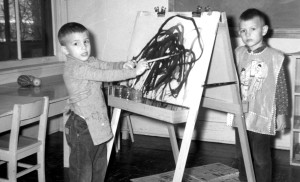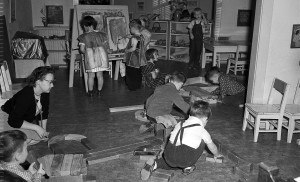Guiding children’s authentic passions
Teachers learn from students just as much as students learn from teachers at the Fishback Center for Early Childhood Education at State.
South Dakota’s only laboratory school celebrates its 85th anniversary this fall, and has undergone many changes.
College students enrolled in the early childhood education program have the opportunity to work with toddler, preschool and kindergarten children, incorporating the knowledge they’ve learned in classes.
“We love the collaboration we have going between professors, students and children,†said Laura Gloege, an early childhood education instructor. “Our program is strong and invites new ways of teaching and thinking.â€
A key advance has been the switch from traditional ways of teaching to inquiry-based teaching and learning.
Inquiry-based learning poses questions, problem or scenarios, rather than teaching from a textbook.
“Learning happens when the students’ authentic passion, questions and interests arise—that is inquiry-based,†said Andrew Stremmel, head of the department of teaching, learning and leadership. “We are not about just transferring information from a book.â€
In 2000, the lab school switched from teaching from allotted themes, to teaching inquiry-based on the children’s questions and interests.
It took four years to fully implement the new method, but it has been successfully used for 10 years.
“It’s more about listening,†said Kay Cutler, director of the Fishback Center for Childhood Education. “Children’s ideas and questions become the basis for our lessons and investigations.â€
According to Cutler, the approach looks like it gives up a lot of control. “But, it’s about redirecting the control, so that the teacher’s interaction with the children provides the direction of the lesson rather than the teacher solely determini ng the direction of the lesson,†said Cutler.
ng the direction of the lesson,†said Cutler.
“There’s a misconception that this way is a free-for-all, which is entirely untrue,†said Stremmel. “It follows the children’s passions and builds on what they want to learn more about. When children want to learn about something, they engage in it entirely.
“If a child on the playground plants a twig in the ground and asks ‘Will a tree grow from this?’ the traditional reply would be something like ‘no, trees grow from seeds, not twigs.’ But with inquiry, we say, ‘Let’s see. Let’s water it and come back tomorrow, then next week, and see if it starts to grow.’ When there’s no growth, we then go through the whys, and answer the child’s questions. There are so many great learning opportunities with inquiry.â€
According to Cutler, the method is widely adopted on the East and West Coasts, and has a natural alignment to the 21st Century Skills and Common Core Standards, which focus on problem solving and new ways of thinking.
“It’s my hope that in 10 years, other preschools and schools in the state will see our preschool as an example, and open up to the inquiry-based method,†said Cutler. “We do have a few inquiry-based preschools sprinkled throughout the Midwest, but I hope even more will become more inquiry-based.
Applying it
Amber Engelhardt is applying inquiry-based methods in her second-grade classroom now. She graduated in December 2012 with a bachelor’s degree in early childhood education and kindergarten endorsement.
The Apple Valley, Minnesota, native always knew she wanted to be a teacher. Her kindergarten teacher and third-grade teacher had a lot of influence on her. “I just always knew this was what I wanted to do when I grew up.â€
Her dream led her to look at colleges with strong education programs. “I went on a summer campus tour, and was really impressed,†said Engelhardt. “I loved the preschool, and knew I wanted to go to SDSU.â€
As for inquiry-based, Engelhardt said she didn’t really understand it when she was going through the program. “I never had a teacher use this method throughout my life, so I wasn’t sure I was even going to apply it in my own classroom after graduation,†she said. “I thought ‘I’m never going to use this in my real job.’â€
Right out of college, Engelhardt substitute taught in Brookings for a semester, and then was offered a job as a mentor teacher in the Fishback Center. “My experience as a mentor teacher taught me so much. But, selfishly, I wanted my own classroom and students. I knew it was time for my new adventure.â€
Her first full-time day in Flandreau was August 19. “I have been learning so much from these second graders. I love it.â€
She’s using inquiry-based me thods in her classroom, alongside traditional methods. “I still do prepare lesson plans every Monday, and turn them in to my principal,†she said. “I’m taking what I have learned from the preschool, using actual materials in the classroom, and doing short-term research projects.â€
thods in her classroom, alongside traditional methods. “I still do prepare lesson plans every Monday, and turn them in to my principal,†she said. “I’m taking what I have learned from the preschool, using actual materials in the classroom, and doing short-term research projects.â€
“We don’t have as much time to do investigations as preschoolers because we have state standards to meet.â€
Engelhardt plans on doing math manipulatives and bringing in people from the community to talk with the students about particular lessons they are studying, giving the students that inquiry-based opportunity to ask questions and base what comes next off what the students want to know.
“I hope that the students in the ECE program understand how important inquiry is,†said Engelhardt. “I know that I’ll never apply it the exact same way that I did at the preschool, but I know I’m capable of figuring out what methods I’d like to use and applying it shorter-term.â€
For classroom investigations, Engelhardt plans on implementing one- or two-weeklong investigation projects.
“I want to use lots of natural materials in the classroom, and be really hands-on,†said Engelhardt. “I think it’s more common now to teach this way than it was when I was in grade school. I’m sure all grade school teachers here use the inquiry-based method to some degree.â€
While she was an undergrad studen t at SDSU, Engelhardt said Mary Bowne, Sue Brokmeier and Laura Gloege were instrumental in her success. “If I ever had a question, I went to one of them,†she said. “I even felt comfortable going to one of them with a question that I thought was dumb at first.â€
t at SDSU, Engelhardt said Mary Bowne, Sue Brokmeier and Laura Gloege were instrumental in her success. “If I ever had a question, I went to one of them,†she said. “I even felt comfortable going to one of them with a question that I thought was dumb at first.â€
Engelhardt said she valued her time in the ECE program and loved how open-minded everyone was. “I could bring my own ideas in and really dig deep into them,†she said. “Everyone supported each other’s ideas. It was like a little family once I got into my junior and senior years of college. I became close with my classmates and my teachers, which was really helpful.â€
This inquiry-based method has been well-received by everyone involved with the Fishback Center for Early Childhood Education, and the entire College of Education and Human Sciences is exploring inquiry-based ideas and possibilities this year, during a “Year of Inquiry.â€
“I hope our teachers and methods influence the change across the field,†said Cutler. “Inquiry-based learning is another way of teaching, and I hope our example shows its value.â€
Karissa Kuhle






